by Paul Dufresne
As discussed in last month’s issue, Endotapping is a physical stimulation of the horse’s neurohormonal system by tapping its body with a special ball type whip. Tapping the horse rhythmically, while it is in a positive emotional shape, causes the horse to release endorphins in its body. This facilitates keeping a horse calm when introducing new stimuli or training challenges.
The first and most important position we have to achieve is the head down below the wither while the horse is in a positive bend around us. The bend should go evenly from the horse’s tail to its poll. This shape is achieved by tapping the horse in the area your leg would hang on if you were riding, while you ask the horse to lower the head and offer its poll. Tapping in zone one, which was demonstrated in the last issue, is very productive in aiding the horse to begin relaxing its body on a lateral bend and then leading to a softer poll. Tapping in zone two aids the horse further in releasing the poll. This approach is the SIMPLEST way I have ever experienced in showing a horse to offer the release of its poll. I have always said, “Control the shape - control the emotions”. It is difficult for me now not to use the endo-whip when convincing a horse to yield and feel good. It accelerates the learning process in such a positive manner.
While tapping and keeping a positive bend around you, watch your horse’s eye. If the eye is looking away from you, the horse is going into mild counter-flexion. The horse may look in proper bend but its head is slightly turned outwards. This type of counter flexion short circuits the relaxation reflexes. With correct application of the tapping technique a horse will soften the top line, willingly lower its head and allow you to easily move the head at the end of its neck as if it were suspended on a string. Horses that carry a lot of anxiety may require a fair amount of tapping before they are willing to let their guard down, but once they begin to relax, the endorphins will start to kick in and before you know it your horse has very little reason to resist.
Why is it so important to get control of the horse’s poll? Quite simply this position is self rewarding for the horse when it is achieved without negative tension. The longer we can convince the horse to stay there the better it feels. The better it feels the less likely it will get into fear/excite cycles. The key is to regroup and bring the horse back to this place any time it gets worried. If you turn this into a cue, much of the resistance in training will disappear. You offer the horse the one thing it most wants - to feel good in hanging around a “herd partner” that is reliable.
All you do is bend the horse around you and begin tapping the body in zone one (the area where your leg would hang if you were riding) while asking the horse with pressure on the lead line or halter to drop its head. As the horse lightens in your hand you cease tapping. Resume tapping any time the horse tries to raise the head up. This simple exercise will turn the tapping into a cue. The horse figures out quickly that the head down causes the tapping to stop. Every time you tap and the horse tries to stop you by putting its head down, it is allowing the flow of endorphins in. Through position and shape we are literally tapping into the natural relaxing reflexes of the horse. The more the horse goes there the more it actually rewards itself and the more likely it is to want to stay there. You want to keep repeating this at a halt, at a walk and later a trot. Once you can reliably get the horse’s poll in a relaxed position this is quite simply the position you ask of the horse to stop a fear/excite cycle.
If there is tension remaining in the top line as you try to gain a positive bend and a relaxed poll, you can utilize a “mini sweep”. As the horse moves forward on the circle you stop your forward motion, open your rein hand (hand holding leadline) slightly away from the horse causing the hind quarters to swing away from you. You then elevate the rein so that the lateral movement of the hind quarters is joined by a lateral movement of the forequarters for one or two steps. Then release and ask the horse to move forward calmly. When you combine this with endotapping, this process can be accelerated even more. This maneuver will change the horse’s shape and help balance the horse on the circle. It is also the lead in to the shoulder-in and leg yield which also help soften the horse, allowing you to get the poll and put them in a happy place.
This should be practiced regularly. Quite simply if you can get the position of the poll with a horse this is where every training session should begin. This sets the emotions in a positive zone for any training you wish to tackle. The next installment will deal with Bomb-Proofing. This is where you can build your confidence and your horse’s emotional reliability. Later I will discuss how to improve performance and therapeutic uses of tapping. Enjoy the euphoric state you will acquire for you and your horse as a relationship without anxiety is always more full-filling.
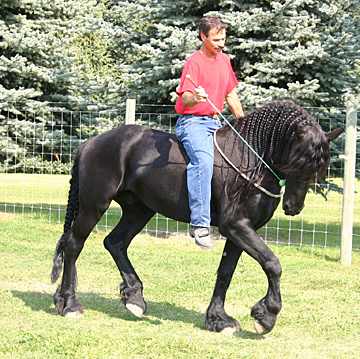
Riding without tack, tapping zone 2
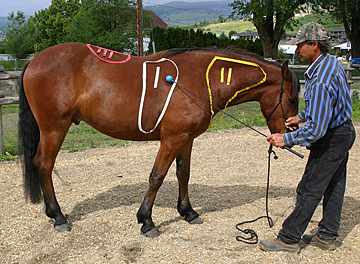
Basic tapping zones on the horse
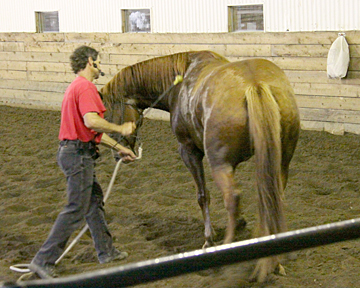
Otis learning to soften after "mini sweeps"
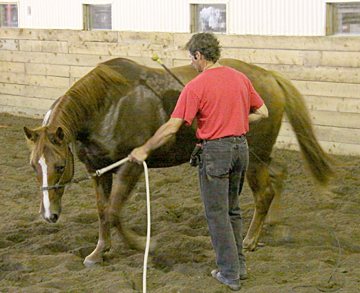
Otis learning to give his poll
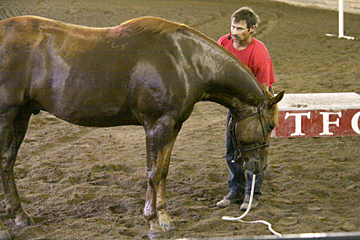
Otis deciding a euphoric state is better than pulling back and
running through things and is enjoying this prolonged
quiet moment where tapping stopped and the endorphins were
taking over. Otis did not have to be sold because he
was
potentialy dangerous. His owner learned to take care of his
needs as a good leader should
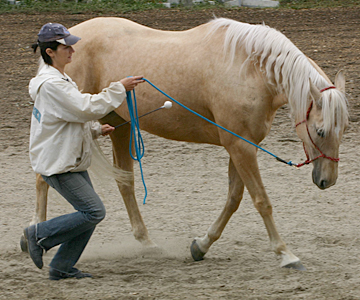
Nicole tapping Solana at the trot, maintaining a soft poll position
trainers and clinicians modify techniques to suit their needs, and the needs of their students - both human or equine. This
technique, when combined with shape control and Natural Horsemanship, I have found to be an exceptional
way to lead a horse and facilitate a very healthy partnership.